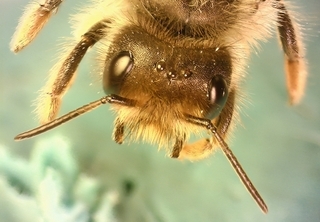 Five hundred feet separate one cluster of 20 or so of hives from the next. Each group is arranged haphazardly, the boxes not quite squared off into neat neighborhoods. The bee quarters look like long, low, flat-roofed slums. Even at 70 mph, I see bare gray wood on the two-storied hives where paint has chipped off. The disheveled arrangement speaks of keepers in a hurry, too busy to care.
Five hundred feet separate one cluster of 20 or so of hives from the next. Each group is arranged haphazardly, the boxes not quite squared off into neat neighborhoods. The bee quarters look like long, low, flat-roofed slums. Even at 70 mph, I see bare gray wood on the two-storied hives where paint has chipped off. The disheveled arrangement speaks of keepers in a hurry, too busy to care.
These are no bee mansions. In other words, hives have not been equipped with extra stories where foraging bees store newly made honey. Pollination is the game here. Honey production is kept to the bare minimum.
Industrial agriculture prizes bees only as pollinators. According to bee expert, Stephan Buchmann, only 25 percent of bees fly solely to collect pollen. The other 75 percent primarily gather nectar; collecting pollen is only a side job. Obviously, in an industrialized bee culture, there is a desire to reverse these percentages. Genetic manipulation has proved somewhat successful in converting more members of the hive to work exclusively on pollination.
 Honeybees, when allowed, still produce their own perfect food. An intensely sweet viscous substance, honey contains 80 percent sugar and 20 percent water. Made from nectar gathered from flowers, honey represents much hard work and flight time. The contents of a 16-once jar of honey represents the efforts of tens of thousands of bees flying over 100,000 miles to gather nectar from more than four million flowers.
Honeybees, when allowed, still produce their own perfect food. An intensely sweet viscous substance, honey contains 80 percent sugar and 20 percent water. Made from nectar gathered from flowers, honey represents much hard work and flight time. The contents of a 16-once jar of honey represents the efforts of tens of thousands of bees flying over 100,000 miles to gather nectar from more than four million flowers.
No comments:
Post a Comment